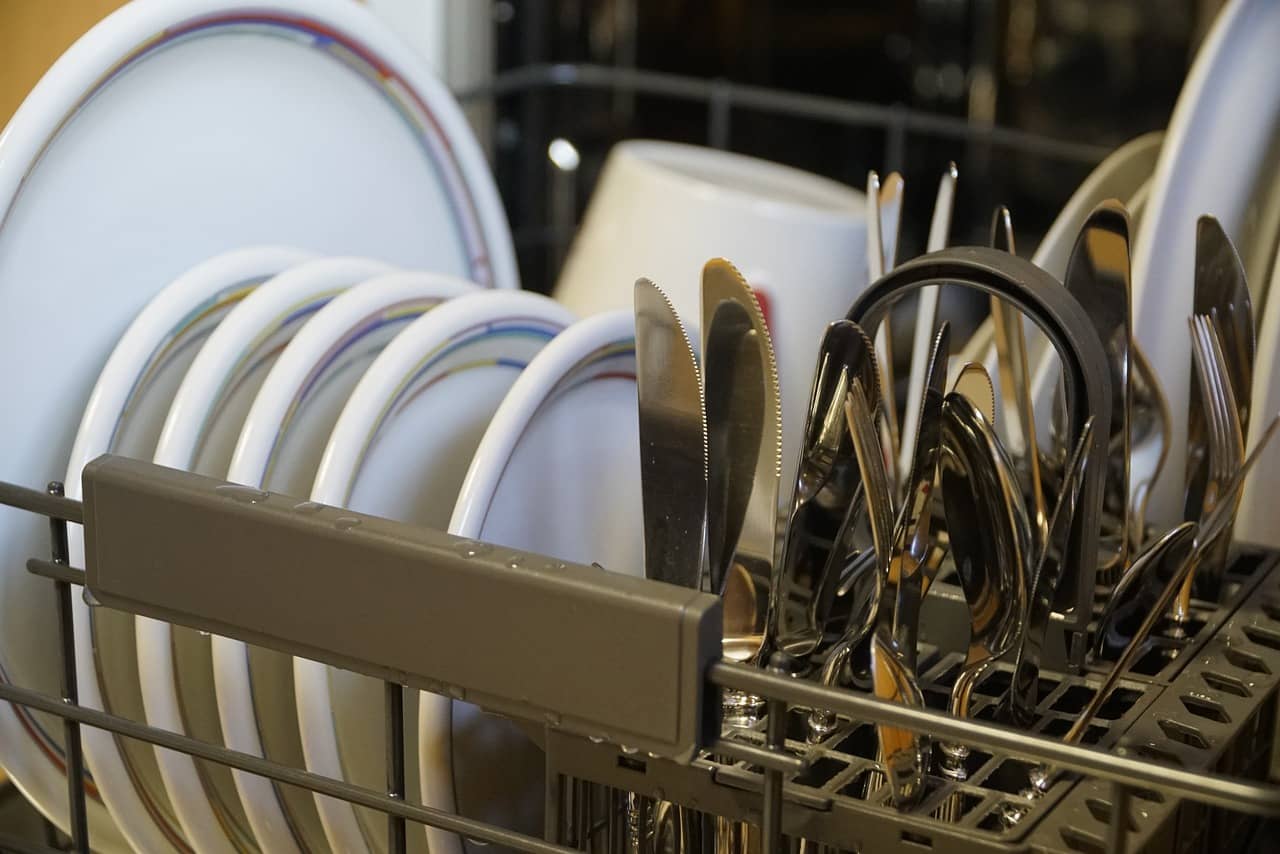Picture the scene, you wake up one morning and stumble to the kitchen. On autopilot, you open the dishwasher, but rather than a clean cup, you find yourself with wet socks. It seems your dishwasher has been leaking.
There are a few things which might cause a leaking dishwasher; perished door seals, problems with the inlet and others. Identifying what’s gone wrong is the first step to fixing it and returning to a life without a pile of dishes in the sink.
Understanding How Dishwashers Work
For a machine that saves so much labor, dishwashers are remarkably simple. You stack your dishes, angled so that strong jets of water can scour the remnants of your dinner away. The water is supplied via an inlet hose and drains away via a pump located at the bottom of the machine.
In effect, a dishwasher is a box containing:
- A water inlet valve which controls how much water is drawn in
- Racks for plates, cups, pans and silverware.
- Spray arms. There are usually two which rotate and blast water at your crockery.
- A pump to remove said water
- A drain hose to conduct the water away once the cycle has ended.
- A seal around the door to ensure that water remains contained
If you find your dishwasher leaking, something amongst these has gone wrong.
Water Flow In Your Dishwasher
As you may expect, water circulates around your dishwasher, pushing grease and particles of food from your dishes. It enters via the inlet valve (which is connected to your water supply via a hose). This controls how much water is being brought in at any one time and will vary the flow during the cycle.
From the inlet, the water is then distributed (usually under a fair bit of pressure) via the spray arms. These are usually positioned right under your dish racks to allow the best access to the objects being washed. They spin as the cycle goes on, ensuring an even distribution of jets of water.
The water is then forced around the machine by a pump, mixing with the detergent which is usually dropped in at some point during the cycle, cleaning your plates thoroughly.
Once the water hits the plates, it rolls off (bashing and splashing as it goes) bringing any lingering dirt with it. It collects in the bottom of the machine where it’s drawn through the filter into the drain hose and then connects with your waste water system.
Common Causes Of Dishwasher Leaks
While there’s nothing terribly complex about dishwashers in a mechanical sense, anything with moving parts is subject to malfunctions. From time to time, things will go wrong and that’s when you’re likely to discover your dishwasher leaking.
If you’re facing a leaky dishwasher, here’s the places to check:
Door Seal Issues
Around the edge of your dishwasher’s door, there should be a rubber seal (known as a gasket). This gets compressed against the body of the machine when the door is closed, forming a watertight seal.
Unfortunately, rubber perishes over time, drying out and becoming brittle. It’s also fairly easy to accidentally damage it or pull it away from its housing. If you’re finding pools of water or a dripping dishwasher door, the first thing to check is the condition of the gasket.
Look for cuts or worn areas and check to see if it’s come loose. Run your hand gently along it if nothing jumps out from a visual inspection. If it’s damaged, it can be relatively easily replaced by contacting your machine’s manufacturer or a local repair shop.
Clogged Or Damaged Drain Hose
The next thing to check is the drain hose. These are made of fairly thin plastic and can be prone to kinking or splitting if they’re not installed properly. As your dishwasher is often dealing with greasy pans and plates and particles of food, it’s also not uncommon for clogs to form over time.
In the case of a kink or clog, water can’t drain properly away. This means that it has to go somewhere and often this will be all over your kitchen floor. A hole forming in the pipe has much the same effect.
To check the state of your drain hose, you’ll have to pull your dishwasher out and follow the gray pipe from it to your waste. Kinks should be fairly obvious and, if they’ve not split the plastic, relatively easy to fix.
Clogs can be removed much the same way as any other blocked pipe. Carefully disconnect from the waste spigot and very carefully use a plastic snake to clear it.
If the hose has split, it will need to be replaced. They tend to be universal, so this should be a fairly straightforward fix once the parts have been located. Make sure that you’re following the instructions for your particular machine as they may have specific requirements in terms of looping.
Faulty Water Inlet Valves
When you turn on your dishwasher, the inlet valve controls the flow of water from the supply into the machine. As with any valve or moving part, they’re subject to wear and tear and will eventually need fixing or replacement.
If you find you have a leaky dishwasher, even when it’s not in use, chances are that the inlet is to blame. Likewise, if the machine is filling slowly (or not at all), it’s almost certainly an issue with the inlet valve.
It could be a hose has come loose or it could be a more serious mechanical failure. There should be an access point located near the bottom front of your machine which will allow inspection. In the case of a loose hose, it should be fairly easy to reconnect it properly. If the valve has failed, you can order replacement parts from your manufacturer.
Misaligned Or Damaged Tub
At its core, a dishwasher is basically a box that fills with water. If something is out of place, or there’s a hole where there shouldn’t be, it’s no great surprise that that water will find a way out. Even something as simple as the machine not being level can put pressure on seals that they’re not really designed for.
Checking your tub for cracks is easy: simply open the door and take a look. Smaller cracks can potentially be repaired with dishwasher safe epoxy (follow the instructions). Larger ones will mean that the tub (or perhaps the whole machine) needs replaced.
Checking for misalignment is also really straightforward. Simply use a level to ensure that your machine is sitting straight. If it’s not and is a free-standing model, there are feet underneath it which should allow you to adjust the position. Simply twist them to raise or lower that corner until the level reads straight.
Overfilling or Water Pressure Issues
If your machine is becoming overfilled, there are two potential culprits.
The float switch which tells your machine when it’s full may have become loose or broken, or there may simply be too much pressure in your plumbing. To test it, you’ll need to open the bottom of your machine, remove the switch assembly and use a multimeter. When it’s on the ‘off’ position your reading should be 0 or infinity. When it’s on, it should show some resistance. If it fails, it needs to be replaced.
To test the pressure regulator, you’ll again have to remove it and make use of a multimeter.
Loose Or Damaged Pump Seals
The pump circulates water around your dishwasher. If the seals around it break or come loose, they can cause leaks.
To check it, you’ll need to tip your machine onto its back and get inside it. Check the state of the seal (it’s a black rubber ring) in the same way you would for the door seal.
How To Diagnose A Dishwasher
Working out what’s gone wrong will take a little bit of detective work and observation.
First things first: check your tub for cracks and misalignment. These are the easiest (and cleanest) things to test as they don’t require a cycle to be running.
Next, see if you can catch the leak in the act. Run a test cycle. The exact method will vary from manufacturer to manufacturer, but this should allow you to pinpoint the leak without too much water ending up on your floor. Pay close attention to the door and hose connections.
If that hasn’t located the issue, it’s time to open up the baseplate. This will allow you access to test the pump, inlet valves and other internal components. You may need a multimeter, flashlight and screwdriver.
Preventative Measures
While fixing a machine is undoubtedly a satisfying experience, it not breaking down in the first place is better.
Some basic discipline while running your machine can help avoid many leaks and drips. Ensure that the spray arms can move freely during the cycle by loading carefully, run regular cleaning cycles with specialized detergent and ensure that hoses are correctly installed and tight.
If you live in a hard water area, ensure your machine is topped up with dishwasher salt regularly or consider a whole-house water softener. This will avoid build up and limescale forming within your machine.
When To Call A Professional Plumber
While you can probably find tutorials online for your particular issue with your particular machine, sometimes something just requires the professional touch.
A plumber will be able to diagnose and repair anything from a leaky door seal to replacing the motor. Their expertise and experience means that more complex repairs should go smoothly. If it’s the case that the machine is beyond saving, they’ll be able to tell you quickly and without fuss.
Whether you go for a DIY fix or call in the big guns, it’s important to act quickly. Leaky dishwashers can put out a lot of water, which can damage floors and will only get worse with time.

